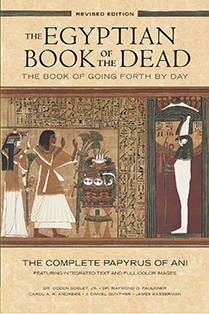|
Dr. Ogden Goelet is a clinical professor of Egyptian Language and Culture in the Department of Middle Eastern and Islamic Studies at New York University. Dr. Raymond Faulkner (1894-1982) was a renowned British Egyptologist, the translator of many important ancient texts, and the author of numerous scholarly publications. Carol Andrews served as assistant keeper/senior research assistant in the Department of Egyptian Antiquities at the British Museum from 1971 to 2000. J. Daniel Gunther is an Egyptological scholar and the author of several works on esoteric symbolism. James Wasserman is an author and book designer whose innovative vision shaped the unique format of this book. Bill Corsa is a co-founder of Specialty Book Marketing and a partner in Studio 31. His expertise includes marketing and sales of special interest nonfiction books and intellectual property rights outside the commercial book trade. |
Producer James Wasserman highlights the changes to this Twentieth Anniversary Edition of The Egyptian Book of the Dead
The Book of Going Forth by Day was first published in 1994 and revised in 1998. This twentieth anniversary edition includes several important new features and twenty new pages.
The first addition is an essay by Egyptological scholar J. Daniel Gunther, who presents an overview of the history of academic research in Egyptian religion and philology during the past two hundred years. The decipherment of the Rosetta Stone in the 1820s began to open the mysteries of ancient Egypt to a world hungry for understanding. Gunther has brought to life some of the trials and passions of scholars who dared journey into a territory that had been wrapped in darkness for millennia.
The second is a critical contribution by Dr. Ogden Goelet, who supervised the original publication; he has compiled an annotated bibliography that replaces and expands upon his twenty-year-old original. It is a state-of-the-art survey of academic sources, especially those created in the past two decades. Dr. Goelet has divided the bibliographical materials into separate categories that include: general studies of Egyptian Afterlife literature; Book of the Dead studies and bibliographies; production techniques of Book of the Dead manuscripts; comprehensive commentaries and translations; suggestions for a program of self-study for the interested amateur; and a selection of online resources. Each section is preceded by a brief introduction that explains its parameters.
The third is a series of improvements to the color images of the Papyrus itself. Some of these were done with reference to the 1979 portfolio of photographs from the British Museum. Other adjustments to the presentation of the scroll were noted during the electronic conversion from its 1993 manual format. All are detailed in a new introduction by James Wasserman, who also discusses the continuing contemporary relevance of ancient Egypt in Western culture.
Here is a list of changes made to the Plates of the Twentieth Anniversary Edition:
Nancy Wasserman restored two small wadjet-eyes on the Djed pillar between Isis and Nepthys on Plate 1b;
She added Thoth’s reed pen on Plates 3b and 31b
The tree goddess on Plate 16a has been made more visible
Another tiny wadjet-eye has been returned to the prow of the solar bark on Plate 18a
Ani and Tutu’s headbands were enhanced on Plate 19a; and the third color of the multicolored mound below the swallow was highlighted on Plate 25a.
In addition, our presentation of the Papyrus has been improved by rejoining the hieroglyphs across the gutter at the top of the page for the names of Geb on Plates 3a and 3b, and Iakedked on Plates 9a and 9b. Very minor aesthetic adjustments were made to Plates 5b and 6a, 7b and 8a, and 8b and 9a.
For ease of reference, we added a and b designations to the numbering of the Papyrus plates.
